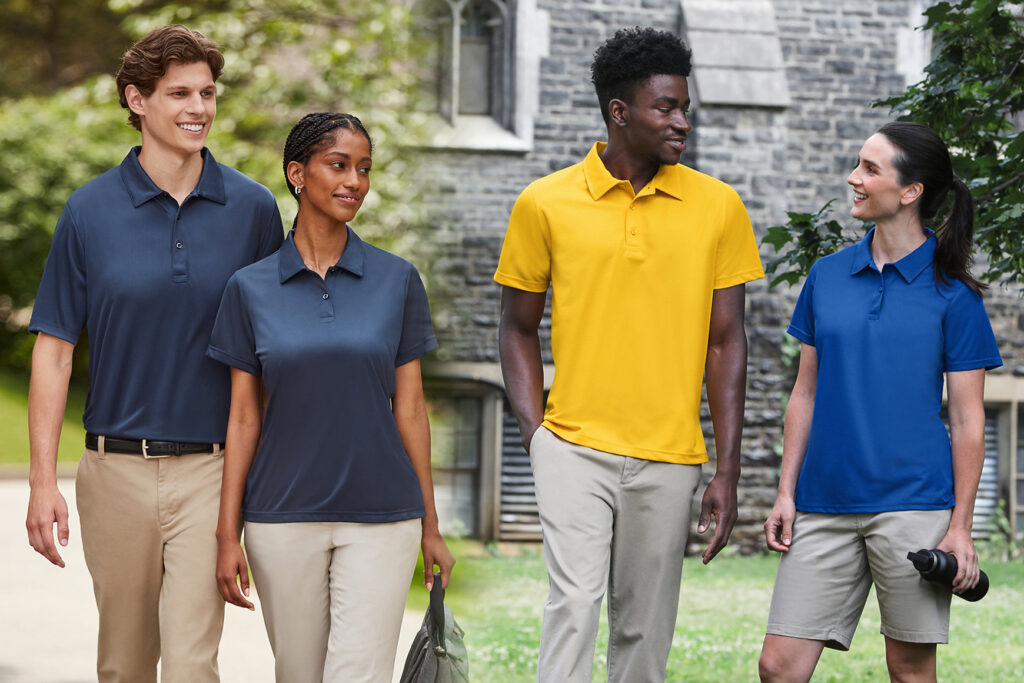Not many of you might remember those heavy cotton uniforms that people used to wear when playing. The ones that end up like a soaked towel after 10 minutes out on the ground. I still wonder why those used to be a thing. But with the advent of synthetic performance fabrics, things changed for the better. Athletic wear, as we didn’t know it, changed to what we know now. Now there is
So what’s the science behind these modern performance fabrics?
Simply put, these fabrics have materials that use advanced technology to pull moisture away from the wearer’s skin and spread it across the fabric’s surface, where it can evaporate quickly. This “wicking” can keep wearers cool even during intense physical activity and at the same time keep them warm during cool-down time.
Building A Performance Apparel Lineup
Let’s start with the most popular fabric in performance apparel. Polyester.
- Rapid moisture-wicking
- Can hold its shape after repeated washing
- Perfect for everyday training gear
- Affordable and durable
These are pretty much why polyester remains popular. However, these traits depend on the fabric quality of the apparel you choose. Some manufacturers earned a reputation for quality that’s dependable. Brands like Team 365 are popular for their performance polos. As a matter of fact, Team 365 polo shirts come in all the right colors to customize for a team, and are built solely for aiding the wearer’s performance when engaged in activities.
Next up on the list is Nylon. Though not as popular or in-demand as polyester, Nylon still remains an essential fabric in the sports apparel market for the following reasons.
- Superior breathability
- Excellent stretch and recovery
- Ideal for compression gear and base layers
- Great abrasion resistance

While Nylon is known to impart stretchability and breathability, Spandex is all about stretchability without compromising shape and mobility. It’s a material that complements other materials like polyester and nylon, ensuring all the characteristics an athlete would expect from their sports apparel.
- Adds stretch to other materials
- Maintains shape during movement
- Mostly seen in performance polo shirts
- Perfect for quick movements
Fabric Blends
Single-fiber fabrics are old news. Real magic happens when you combine materials. A polyester-spandex blend gives you moisture-wicking with just enough stretch. Add some nylon, and you’ve got a fabric that offers maximum breathability.
For scorching summer practices, the performance wear could use:
- Lightweight polyester meshes
- Open-knit structures for maximum airflow
- Side vents
- UV-protection
- Light colors to reflect sunlight
Training in chilly climates call for:
- Interiors with smooth texture (polyester works)
- Moisture-wicking base layers
- Reasonably wind-resistant outer layers
- Side vents
- Reflective elements
For strenuous physical training, go for:
- Abrasion-resistant fabrics for high-contact areas
- Fabrics with the right kind of stretchability to ensure unrestricted movement
- Fabrics with odor resistance
- Fabrics that dry quick
- Durable fabrics
For casual physical leisure:
- Medium stretchability
- Wrinkle-resistance
- UV protection
- Professional appeal
- Moisture-wicking
Budget-Smart Shopping Tips
Quality performance wear doesn’t always mean expensive, if you can find a wholesale supplier offering just what you need at prices that won’t give you second thoughts.

When sourcing performance apparel for your team,
- Always buy in bulk to get the best per-piece pricing
- Buy during special sales for extra benefits
- Take last season’s styles into account
- Research more on brand names and their values
Getting performance wear from a brand that’s generally praised for fashion basics may not be the right call. I recommend going for brands that specifically focus on team performance and looks.
Picking the right performance fabrics for your team may not be rocket science but still requires considerable investment of your time understanding if the fabric suits the need of the hour. Focus on the sport’s specific demands and consider the local climate. It’s best to start with a small test order of the apparel before making a big commitment. Let your athletes put them through their paces during practice. Their feedback will be your best guide to making the right choice for your team.


